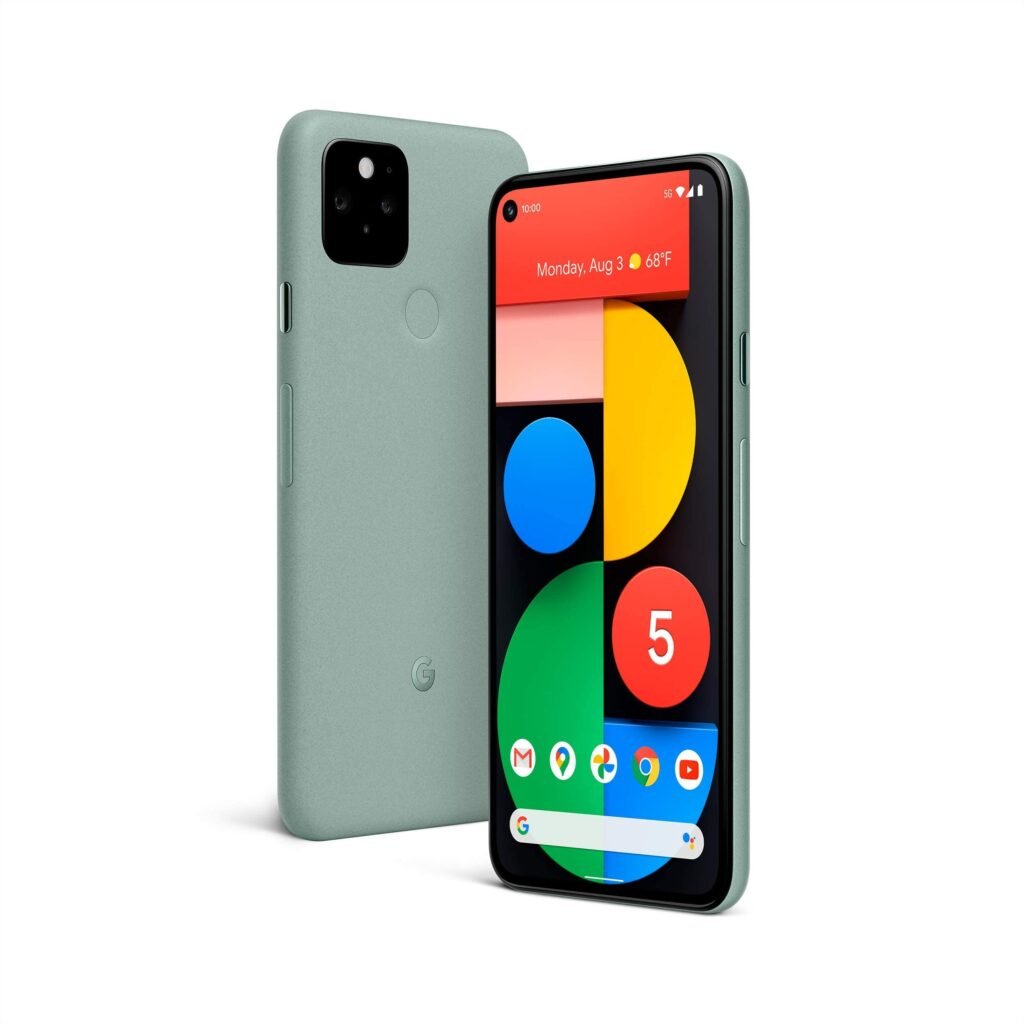After the ambitious but somewhat divisive Pixel 4, Google took a different approach with the Google Pixel 5, launched in the fall of 2020. Instead of pushing experimental features and premium pricing, the Pixel 5 aimed for a more balanced, value-focused flagship experience. It only came in one size, effectively merging the standard and XL lines, and launched alongside the similarly capable, but slightly lower-spec’d, Pixel 4a 5G.
Design: Refined Simplicity, Familiar Comforts Return

The Pixel 5 sported a clean, minimalist design with some notable changes:
- Uniform Bezels & Hole-Punch: It featured a 6.0-inch OLED display with slim, uniform bezels all around, thanks to the use of a hole-punch cutout for the front camera.
- Metal Body, Clever Charging: The body was made of aluminum, but coated in a unique “bio-resin” (essentially a textured plastic-like paint). This coating allowed Google to cut a hole in the aluminum underneath for the coil, enabling wireless charging – a clever workaround to have both a metal build and wireless charging capabilities. It also supported reverse wireless charging (“Battery Share”) to top up earbuds or other devices.
- Fingerprint Sensor is Back! Responding perhaps to feedback on the Pixel 4, Google brought back the beloved rear-mounted capacitive fingerprint sensor (Pixel Imprint), ditching the Face Unlock system and the large top bezel required for it.
- Durability & Feel: It maintained IP68 water and dust resistance. The bio-resin finish gave it a unique, slightly textured feel distinct from glass or bare metal. Colors were limited to “Just Black” and a distinctive “Sorta Sage” green.
- No Headphone Jack, No Active Edge: The headphone jack remained absent, and the Active Edge squeeze feature was also removed.
Hardware: A Strategic Step Back for Better Balance?
The biggest indicator of Google’s strategy shift was the processor choice:
- Snapdragon 765G: Instead of the top-tier Snapdragon 8-series chip found in the Pixel 4, the Pixel 5 used the very capable upper-mid-range Snapdragon 765G. This chip provided integrated 5G support (both sub-6 and mmWave) and excellent efficiency, allowing Google to hit a lower price point ($699) while still offering smooth performance for most users.
- RAM Upgrade: RAM was bumped up to a healthy 8GB, aiding multitasking.
- Storage: Came standard with 128GB of UFS 2.1 storage (non-expandable).
- 90Hz Smooth Display: The excellent 90Hz refresh rate OLED display carried over from the Pixel 4, providing fluid scrolling and animations.
- Battery Champion: Addressing a major pain point of the Pixel 4, the Pixel 5 packed a much larger 4080mAh battery. Combined with the more efficient 765G chip, this resulted in significantly improved, often excellent, battery life.
- Security: The Titan M security chip was retained.
Cameras: Swapping Telephoto for Ultrawide
The Pixel 5 kept a dual-camera system but swapped one lens type:
- Main + Ultrawide: It featured the familiar, excellent 12.2MP main sensor (f/1.7, OIS+EIS, Dual Pixel AF) paired with a new 16MP ultrawide camera (f/2.2, 107° FOV). This addressed a common criticism of the Pixel 4 lacking an ultrawide option, though it meant sacrificing the dedicated telephoto lens. Zoom was handled purely by Google’s Super Res Zoom software.
- Front Camera: A standard 8MP front camera was housed in the hole-punch.
- Software Still Shines: Google continued to leverage its software prowess. Night Sight (with Astrophotography), Portrait Mode (now with “Portrait Light” to adjust lighting on faces post-shot), Live HDR+, and Super Res Zoom were all present and excellent. It also introduced a new “Cinematic Pan” stabilization mode for smoother video recording and was the first Pixel capable of 4K video at 60fps.
Software: Android 11 and Pixel Exclusives
Launching with Android 11, the Pixel 5 delivered the clean, intelligent experience users expected, complete with exclusive features like Call Screen, Hold for Me, and the Recorder app. It received OS updates up to Android 14, with support ending in October 2023.
Reception and Legacy: A Welcome Return to Form?
The Pixel 5 was generally well-received as a pragmatic and appealing flagship. Its more accessible $699 price, significantly improved battery life, the welcome return of the fingerprint sensor, the addition of an ultrawide camera, ample 8GB RAM, and the consistently great camera and software experience were major positives.
Criticism tended to focus on the use of a mid-range processor (even if performance was good in practice), the slightly less premium feel of the bio-resin coating compared to glass, and the lack of a telephoto lens. However, for many, the Pixel 5 represented a smart course correction, focusing on the core strengths of the Pixel line – camera, software, and user experience – within a more balanced and reasonably priced package. It successfully redefined Google’s approach to its main Pixel device for that cycle.
